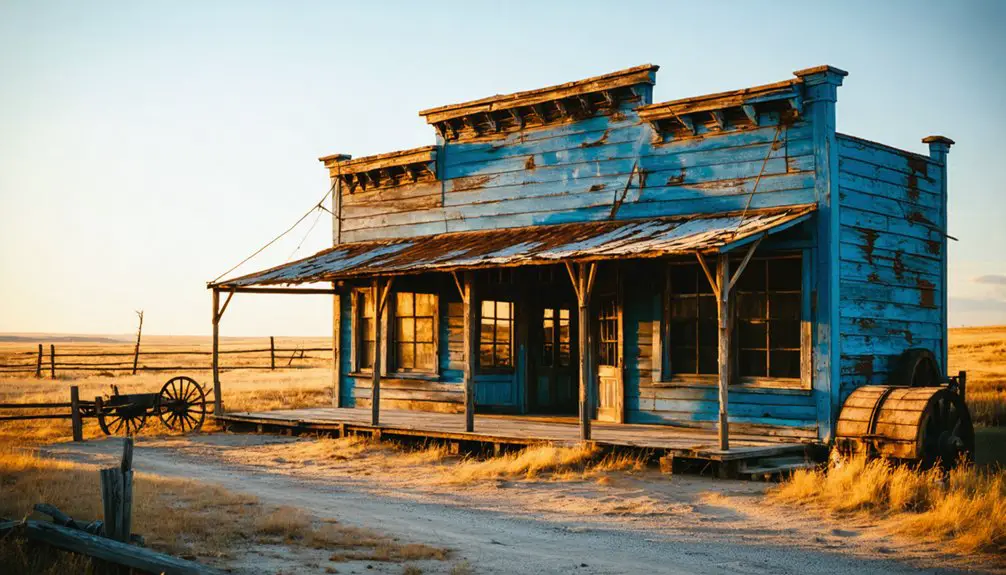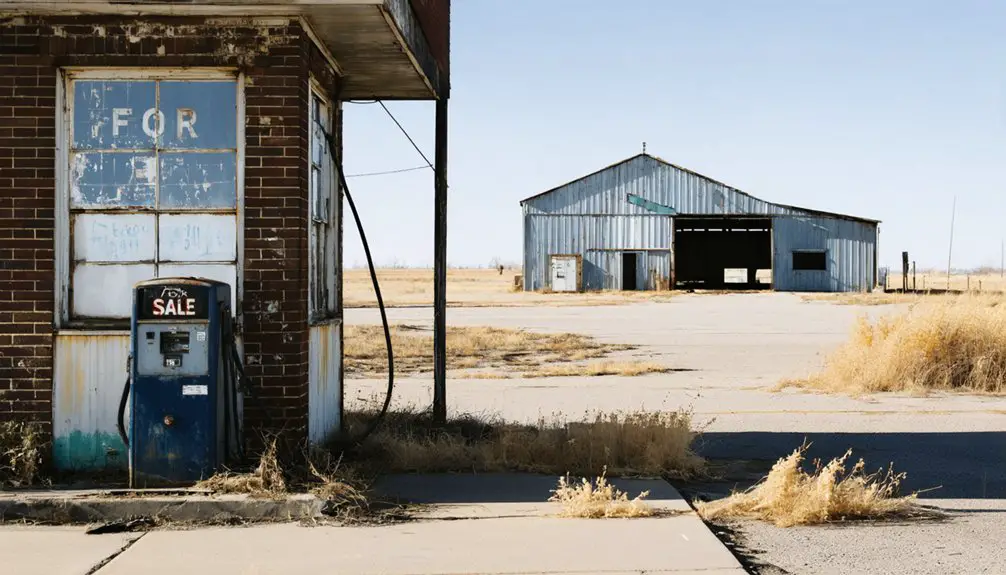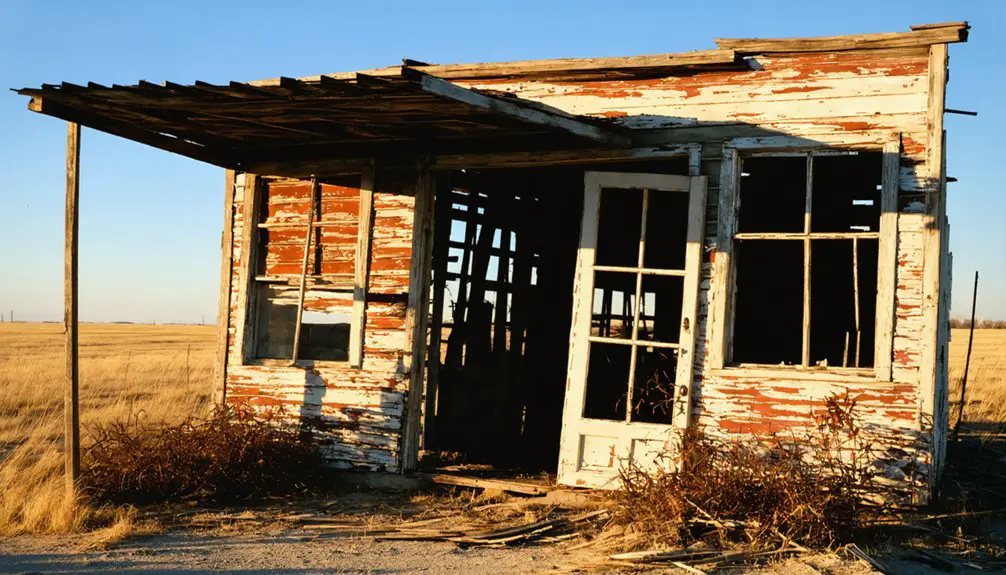You’ll find Ulysses, Kansas isn’t your typical ghost town story – it’s a tale of survival through community action. When faced with crushing bond debt in 1909, residents literally picked up their entire town and moved it three miles away using horse power and wooden skids. While the original townsite became a ghost town with only a masonry school remaining, the relocated Ulysses thrived and remains Grant County’s only incorporated town. The remarkable story of this prairie town’s preservation holds even more surprising turns.
Key Takeaways
- The original Ulysses became a ghost town in 1909 when residents moved the entire community three miles to escape bond debt.
- Only a masonry schoolhouse remains at the original Ulysses townsite, marking where the first settlement once stood.
- Using wooden skids and horse power, residents relocated buildings and homes to the new site over four months.
- The town’s population had already declined from 2,000 to 100 by 1908 due to severe droughts and crop failures.
- The Hotel Edwards from the original site was preserved and now stands at the Grant County Museum.
The Birth of a Prairie Town (1873)
Three significant events marked the birth of Ulysses, Kansas in 1873: its official establishment on March 20th, the creation of Grant County, and the surveying of its original townsite two miles east of its present location.
Under the guidance of George Washington Earp, cousin to the famous Wyatt Earp, early settlers faced founding challenges as they built their new community on government land. The town quickly grew to reach a population of 2,000 within its first fifteen years.
You’ll find it fascinating that this land, once home to the Pawnee, Osage, Arapaho, and Comanche tribes, transformed as the Santa Fe Trail‘s importance waned with the arrival of steam engines in western Kansas. The discovery of the vast Hugoton gas field in the 1920s brought renewed prosperity to the region.
The town’s connection to President Ulysses S. Grant ran deep, as both the county and township proudly bore his name, marking the beginning of a new chapter in Kansas’s western frontier.
The Earp Family Connection
You’ll find a powerful connection between Old Ulysses and the Earp family through George Washington Earp, Wyatt Earp‘s first cousin, who surveyed the original townsite and became its first postmaster at age 21.
As the townsite agent and manager for the Ulysses Town Company, George’s civic leadership expanded to include roles as mayor and constable, sharing his famous cousin’s reputation for skilled firearms handling. Like his cousin Wyatt who excelled at horse racing and gambling in California, George brought his entrepreneurial spirit to Ulysses.
The Earp family’s influence stretched across western Kansas’s frontier settlements, with George choosing Ulysses over the more dangerous Dodge City after heeding Wyatt’s advice. Born in Missouri in 1864, George Washington Earp had long dreamed of making his mark on the American frontier.
Earp’s Law Enforcement Legacy
The Earp family left an indelible mark on Kansas law enforcement during the turbulent 1870s, particularly through the actions of brothers Wyatt, Virgil, Morgan, and James. Their frontier justice approach shaped how you’d view law enforcement in the American West, combining official authority with personal vendettas against outlaws and criminals.
While serving in various positions from Wichita to Dodge City, the Earps developed a complex legacy. During this period, Wyatt gained significant experience managing drunken cowboys during intense cattle drive seasons. After being fired from the Wichita police force due to conflicts with Marshal Smith, Wyatt relocated his operations to Dodge City.
You’ll find Wyatt’s reputation as a tough but controversial lawman reflected in his aggressive pursuit of stage robbers and cattle thieves. Virgil’s influence as Deputy U.S. Marshal set standards for maintaining order in booming frontier towns.
Though their methods sometimes sparked criticism, especially regarding brothel connections and controversial tactics, the Earp legacy embodies the raw, uncompromising nature of Kansas frontier law enforcement.
Town Survey and Planning
While the Earp brothers made their mark through law enforcement, another Earp family member helped shape Ulysses from its very foundations.
George Earp, Wyatt’s first cousin, supervised the critical land surveying work that established Ulysses in 1885. As the elected town site agent, he oversaw the meticulous plotting of the settlement using the Public Land Survey System – a nationwide standard that employed chains for precise measurements. Like the cunning Greek hero for whom the town was named, George Earp demonstrated strategic planning in his work.
Town planning required exacting attention to detail, with surveyors marking township lines every six miles and making corrections for the Earth’s curvature.
George Earp’s work laid the groundwork for an orderly distribution of land claims under the Homestead Law and Timber Culture Act, ensuring settlers could stake their claims with confidence in the accuracy of property boundaries. The Ulysses Town Company founded the town site in June 1885 after government land became available for purchase.
Wild West Family Ties
Among the most influential frontier families to shape Ulysses’ early development, the Earp clan left an indelible mark through George Washington Earp‘s leadership.
As a first cousin to the legendary Wyatt Earp, George brought the family’s reputation for frontier justice and civic dedication to this Kansas settlement. The Earp name carried significant weight in the region, as six Earp ancestors had fought valiantly in America’s colonial wars.
While you might know about Wyatt’s famous exploits, the Earp family’s influence in Ulysses took shape through George’s contributions:
- Surveyed and platted the original townsite in 1885
- Served as the town’s first postmaster at age 21
- Led the community as both mayor and constable
- Helped establish essential infrastructure, including the town’s first hotel
The Earp family’s commitment to law enforcement and community building exemplified the spirit of western expansion, shaping Ulysses’ early character and development. During the contentious county seat battle of 1888, George’s leadership was crucial as the Town Company hired gunmen to maintain order during the election process.
Moving an Entire Town: A Bold Strategy
You’ll discover that when facing crushing bond debt in 1909, the resilient citizens of Ulysses took the extraordinary step of relocating their entire town three miles away.
Using skids and determination, they transported homes, businesses, and even the massive Hotel Edwards across the prairie to establish what would become New Ulysses in Grant County.
The physical relocation allowed the community to escape financial ruin while preserving their town’s identity, as they strategically left behind the debt-burdened land of Old Ulysses.
Debt-Driven Community Migration
In one of America’s boldest acts of community preservation, the residents of Ulysses, Kansas executed a remarkable plan to physically move their entire town three miles across the prairie in 1909. This debt migration showcased extraordinary community resilience in the face of crushing financial obligations from their failed county seat bid and crop failures.
Here’s what made this audacious move possible:
- Buildings were loaded onto skids and transported piece by piece, including the massive Hotel Edwards.
- The new location, “New Ulysses,” legally freed residents from old townsite debts.
- By relocating outside the original school district, they escaped additional tax burdens.
- The community preserved their architectural heritage while starting fresh financially.
This bold strategy ultimately saved Ulysses from becoming another Kansas ghost town, proving that sometimes freedom requires radical action.
Skids and Prairie Journey
The physical relocation of Ulysses stands as a demonstration to the ingenuity and determination of early 20th-century pioneers.
You’ll marvel at how these resourceful settlers transported an entire town across the prairie using nothing but wooden skids, horse power, and sheer willpower.
The journey wasn’t simple – buildings had to be moved 2-3 miles west over challenging terrain.
You can picture teams of up to 60 horses working together to pull massive structures through Lakin Draw, maneuvering both downhill and uphill slopes.
Larger buildings were sectioned for easier skid transportation across the prairie obstacles.
From February to June 1909, the community united in this remarkable endeavor, moving everything from homes to businesses.
The courthouse and post office remained until last, ensuring essential services continued throughout the shift.
The Battle for County Seat Status

When Grant County was re-established in June 1888, a fierce battle erupted between Ulysses and Tilden (later Appomattox) for the coveted county seat status.
The contest quickly descended into corruption, with both sides engaging in vote buying and election fraud that tore the community apart.
Here’s what you’ll find shocking about this turbulent period:
The shocking truth behind Grant County’s dark past reveals a tale of greed, corruption and unbridled ambition.
- Ulysses city council bonded $36,000 to pay “professional voters” $10 each
- Over 300 fraudulent votes were discovered by state authorities
- A Tilden supporter, Alvin Campbell, was tarred for exposing the corruption
- Both towns employed intimidation through “professional toughs”
Despite multiple legal battles reaching the Kansas Supreme Court, Ulysses ultimately prevailed in the 1890 election, securing its position with 180 votes to Appomattox’s 136.
Surviving While Others Vanished
While other Grant County towns faded into history, you’ll find that Ulysses secured its future through a remarkable combination of maintaining county seat status and executing a strategic three-mile relocation west in 1909.
You can trace the town’s survival to this bold decision by residents to move their entire community rather than succumb to crushing bond debt, which had doomed many frontier settlements.
Your community stands today as the county’s sole remaining incorporated town, outlasting nearly 20 other local settlements through political savvy and adaptive planning.
County Seat Power Play
During the late 1880s, Ulysses and Appomattox engaged in a fierce battle for Grant County’s seat designation, with both towns resorting to vote-buying schemes and electoral fraud to secure this coveted status.
The electoral manipulation reached shocking levels when Ulysses’ city council bonded $36,000 for vote purchasing, while similar tactics emerged in Appomattox.
You’ll be amazed by the extent of their determination:
- Professional voters received $10 payments to cast ballots
- Over 300 fraudulent votes were discovered in the 1888 election
- The Kansas Supreme Court mandated a new election due to widespread vote manipulation
- The final 1890 election settled the dispute with Ulysses winning 180 to 136
Despite the controversial methods, Ulysses’ victory as county seat proved essential for its survival, while neighboring towns faded into obscurity.
Strategic Town Relocation Success
Faced with crushing debt and dwindling population, Ulysses’ residents made an extraordinary decision in 1909 that would save their community from extinction. Rather than submit to crippling bond payments, they chose strategic relocation, moving their entire town three miles across the prairie.
You’ll find their community resilience on full display as they placed buildings on skids, including the massive Hotel Edwards which they cut into three sections for transport.
By abandoning the original townsite to bondholders and establishing “New Ulysses,” residents preserved their social fabric while shedding oppressive financial obligations. This bold move paid off – while many Kansas towns disappeared into history, New Ulysses thrived.
Today, you can still visit the preserved Hotel Edwards at the Grant County Museum, a symbol of one community’s determination to control its destiny.
Last Town Standing Today
Among the many frontier settlements that once dotted Grant County’s landscape, Ulysses stands alone today as the only incorporated town with an active post office.
The town’s resilience and strong community identity have kept it thriving while towns like Appomattox, Golden, and Zionville faded into history.
You’ll find Ulysses’ remarkable survival story rooted in several key factors:
- Securing its position as county seat in 1890, providing a stable administrative anchor
- Making the bold decision to relocate the entire town in 1908 to escape crushing debt
- Maintaining effective law enforcement under George Washington Earp’s early influence
- Leveraging its strategic location along transportation routes to sustain economic growth
Today, Ulysses preserves the legacy of Grant County’s frontier spirit while other settlements exist only in memory.
Notable Crimes and Social Unrest
The lawless frontier spirit that defined Ulysses, Kansas manifested in numerous violent crimes and social upheavals throughout its history.
You’ll find historical mysteries like the notorious 1884 murder of Nellie Henson, where ghostly encounters were reported near the crime scene.
The town’s darkest chapter emerged during the late 1880s when corruption plagued local politics – vote buying, intimidation, and public retaliation against whistleblowers became commonplace.
You can trace how this lawlessness culminated in one of the West’s bloodiest gunfights, surpassing even the OK Corral in violence.
The town’s social fabric continued unraveling through financial scandals, leading to massive debt and population exodus.
Even in modern times, serious crimes persist, as evidenced by the 2008 double murder case.
The Santa Fe Trail’s Influence

Since its pioneering by William Becknell in 1821, the Santa Fe Trail profoundly shaped Ulysses’s development and the surrounding Kansas landscape.
The trail’s commercial dynamics transformed the region into a bustling corridor of trade routes, connecting Missouri markets with the Southwest.
You’ll discover how the trail’s legacy lives on through these transformative impacts:
- Ulysses’s strategic position along the Cimarron branch made it an essential stop for merchants and settlers.
- The town’s establishment in 1873 coincided with the trail’s peak commercial period.
- Military forts like Fort Larned and Fort Dodge protected the region’s trade activities.
- The arrival of the Atchison, Topeka & Santa Fe Railway enhanced the town’s connection to broader markets.
These elements created a rich tapestry of commerce that continues to influence the region’s identity today.
Grant County’s Lost Communities
While Grant County once thrived with more than a dozen distinct communities, today you’ll find only three recognized settlements remaining: Ulysses, Hickok, and Ryus.
The dramatic decline of these frontier towns tells a compelling story of community resilience against formidable challenges.
During the 1930s, the county’s population plummeted by 37% as residents fled the devastating effects of the Dust Bowl.
Many towns simply couldn’t survive the environmental and economic hardships. The closure of essential services, loss of railroad connections, and fierce competition for county seat status sealed the fate of numerous settlements.
Historical preservation efforts now focus on documenting these lost communities, which emerged during the 1885-1887 settlement boom when the region transformed from cattle ranching territory to agricultural claims.
Economic Struggles and Adaptation

From its earliest days as county seat, Ulysses faced devastating economic challenges that threatened its very existence. The town’s remarkable display of economic resilience emerged through community cooperation when residents chose a bold solution to escape crushing debt.
- The population plummeted from 2,000 to just 100 by 1908, driven by crop failures, droughts, and the exodus of settlers to Cherokee Strip.
- East Coast bondholders threatened foreclosure on the original townsite due to unpaid public improvement debts.
- You’ll find evidence of ingenuity in their 1909 decision to physically move the entire town three miles to escape debt.
- Despite agricultural mechanization reducing rural populations throughout the 20th century, the community preserved its identity through adaptive strategies.
Their survival story demonstrates how determined citizens can overcome seemingly insurmountable financial obstacles.
Legacy of the Town’s Relocation
The 1909 relocation of Ulysses stands as one of America’s most remarkable examples of community preservation through physical town movement.
You’ll find evidence of this historical preservation in the Hotel Edwards, now restored at the Grant County Museum, which workers had to cut into three sections to transport to the new site.
While the original site became a ghost town with only the masonry school remaining, the community’s resilience shines through in how they maintained their identity just three miles away.
By moving their homes and businesses rather than abandoning them, residents preserved both their physical structures and social bonds.
Their creative solution to financial hardship – relocating entire buildings on skids to escape crushing debt – demonstrates how determination and unity can help a community survive against overwhelming odds.
Frequently Asked Questions
What Was the Population of Ulysses During Its Peak Years?
You’ll find the population trends reached their historic peak around 2,000 residents in 1888 during the boom years, when your community thrived with numerous businesses before financial troubles forced relocation.
How Did the Great Depression Affect Ulysses Compared to Other Kansas Towns?
You’ll find Ulysses experienced similar Depression impact through business closures and unemployment, but faced unique economic challenges with severe dust storms destroying crops and forcing mass exodus from local farms.
Were There Any Significant Native American Settlements Near Ulysses Before Founding?
Like shadows on the prairie wind, Native American tribes – primarily Comanche, Kiowa, and Apache – used the area around you for seasonal hunting camps rather than permanent settlements before Ulysses’ founding.
What Role Did Women Play in Early Ulysses Government and Business?
You’ll find women’s leadership emerged through informal roles in education and social welfare, while their economic contributions centered on running boarding houses, small businesses, and providing essential community services.
Did Ulysses Have Any Connections to Famous Outlaws Besides the Earps?
While there’s no smoking gun linking famous outlaws to Ulysses, you’ll find frontier justice influenced by local “professional toughs” who used outlaw-style intimidation during heated county seat battles.
References
- https://www.legendsofamerica.com/ks-ulysses/
- https://digging-history.com/2014/10/15/ghost-town-wednesday-old-ulysses-kansas/
- https://theactiveage.com/these-kansas-towns-didnt-stand-a-ghost-of-chance/
- https://ulyssesnews.com/stories/the-ghost-of-the-cimarron
- https://fhsuguides.fhsu.edu/kansasheritage/grantcounty
- https://www.bradycarlson.com/ulysses-kansas-the-town-that-moved-a-couple-miles-down-the-road-cool-weird-awesome-973/
- https://en.wikipedia.org/wiki/Ulysses
- https://en.wikipedia.org/wiki/History_of_Grant_County
- https://www.historynet.com/earp-fellow-sophisticates-these-men-knew-them-when/
- https://www.legendsofamerica.com/george-earp/



